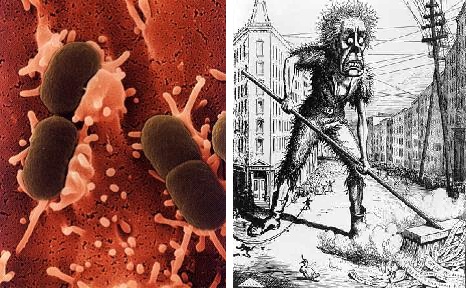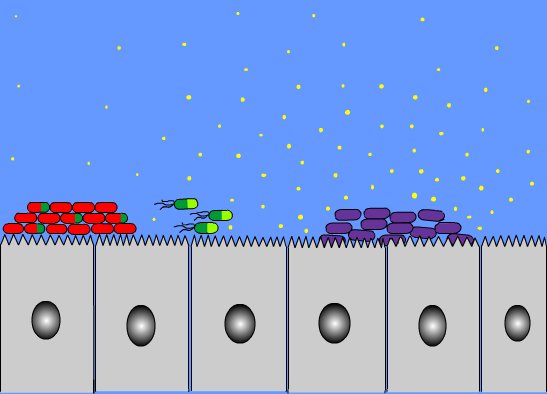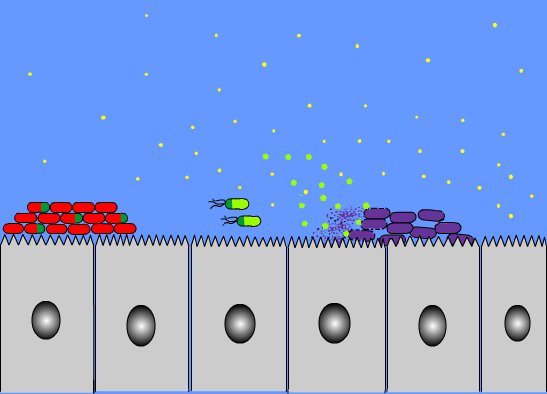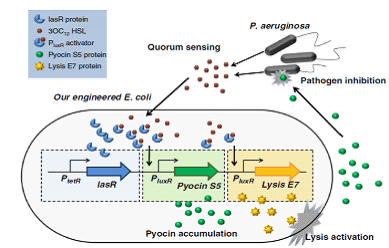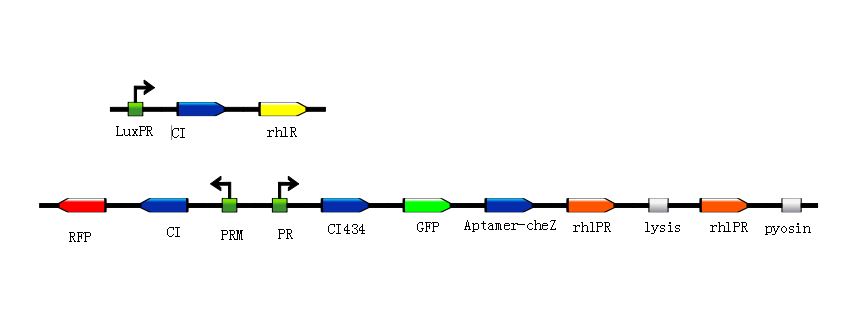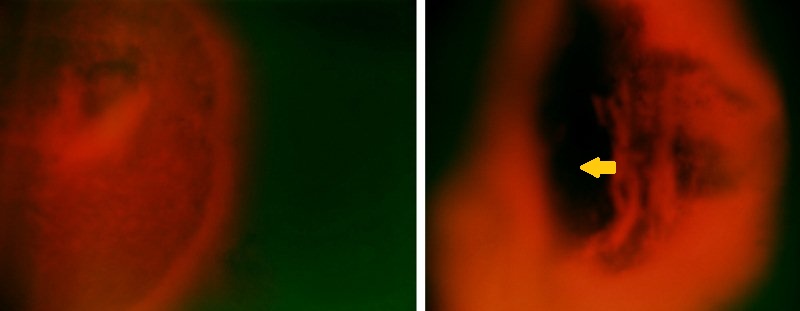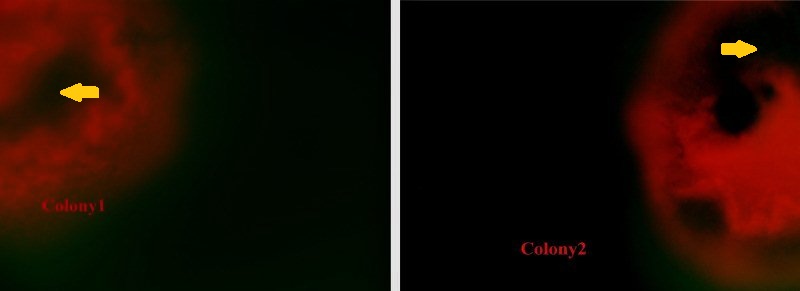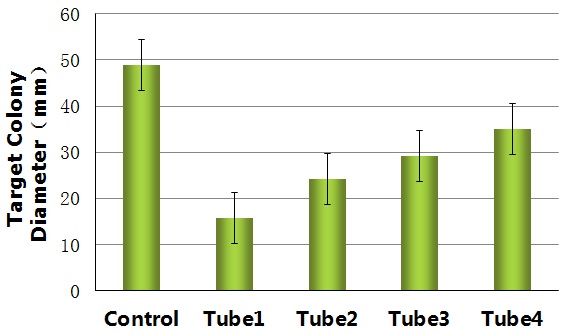Team:USTC-China/Project/futurework
From 2011.igem.org
Contents |
Artificial Innate Immunity System(AIIS)
Background
From mid May to June 2011, enteropathogenic E.coli brings a big panic to many different European countries. Why such an ordinary bacteria as E.coli can lead to a clinical catastrophe and kill a lot of people? The answer may be complicate, but the most important reason is that we can not find out the pathogens rapidly and can not apply the effective treatments.To solve this problem, we try to use the normal E.coli, which keep the symbiotic relationship with us humanbeings, to be a safety weapon to defend ourselves against pathogens.
Figure1.Enteropathogenic Escherichia coli(left) brings us a big panic(right,Frank Bellew, New York Daily Graphic, September 29, 1873)
Purpose
Using reprogrammed intestinal bacteria as a safety weapon to destroy the pathogens which invade the intestinal mucosal system.
Principle
As shown in Figure2, When pathogens invade the intestinal epithelium ,they will release some kind of chemical signal. After the reprogrammed intestinal bacteria capture this signal, such signal can activate the expression of the function gene ,then it will drive the reprogrammed intestinal bacteria to move toward the infection site from the original colony. Then the moving reprogrammed bacteria will establish a new colony at the infection site, these bacteria will express some lethal proteins to kill pathogens by self-destruction, or spread some toxic small molecules to destroy the pathogens then start self-destruction, and the original colony will remain.
(a)
(b)
Figure2.Reprogrammed intestinal bacteria move towards the target and establish a colony(a),then destroy the taget(b)
Theoretical Design
1.AI(Auto Inducer)as a Chemical Signal
By using the device from the article Engineering microbes to sense and eradicate Pseudomonas aeruginosa, a human pathogen (Figure3.), we can modify our original design to achieve the function which we have described before.(As shown in Figure4.)
Figure3.
Figure4.
In this design, the rhlPR is a RHLR/RHL Inducible Promoter, and we can assume the AI comes from pathogen is RHL. So the reprogrammed bacteria will move toward the the infection site with a high concentration of RHL and stop, then they will decompose and release the pyosin to destroy the pathogens.
2.Other small molecules as chemical signals
By using the device from the article Engineering microbes to sense and eradicate Pseudomonas aeruginosa, a human pathogen (Figure 3.), we can modify our original design to achieve the function which we have described before(Figure 5.).
Figure5.
In this design, we assume the small molecule is theophylline. So the reprogrammed bacteria will move toward the infection site with a high concentration of theophylline, while the expression of Lysis becomes more and more. As the bacteria stop moving, they will destroy themselves and release the Pyosin, which is expressed at the beginning of the process, to kill the pathogens.
Besides, the Lysis protein can be replaced by ccdB protein, and the Pyosin also can be substituted by other proteins of destruction, and the theophylline also can be replaced by other small molecules or catalyzed from other molecules like caffein or amino acid.
Experimental Design and Results (protocol)
To put the original Toggle Switch-Aptamer-cheZ in use, we choose the second design above(As shown in Figure 5.) to be the experimental construction(Figure 6.).
Figure6.
In this design, we use biobrick BBa_K117000 as the Lysis protein, and use biobrick BBa_K117001 to replace the pyosin. In which, the biobrick BBa_K117001 is ColE7-ImmE7 protein complex, and the lysis protein can remove Immunity protein from the complex with ColE7, then ColE7 regains its toxicity and ability to kill the EHEC bacteria or other bacteria nearby. Lysis protein itself can induce the lysis of host cell, exposing the interior cell contents and hence allows free diffusion of ColE7 proteins towards pathogenic bacteria strain.
Under the consideration of bio-safety, we just use the ordinary E.coli strain with the chloramphenicol and tetracycline resistance as the target bacteia. After the experiment (details are shown in the Protocol), we have some reliable results shown below.
Figure7.
Figure7 shows the fluctuation of expression of the Toggle Switch device, the number of bacteria with red fluorescent decreases from tube1 to tube2.
Figure8.The growing state of the target bacteria. Left(after 3h), Right(after 10h)
Figure8 shows the growing state of the target bacteria as the control of the experiment, in which the red circle represent the range of motion of the target, and from left to right the concentration of the theophylline increases.
Figure9.The growing state of the reprogrammed bacteria(colony1,from tube2) and the target bacteria(colony2). Left(after 3h), Right(after 10h)
Figure9 shows the growing state of the reprogrammed bacteria(from tube2) and the target bacteria, in which the yellow circle represent the range of motion of reprogrammed bacteria and the red circle represent the range of motion of the target bacteria, and from left to right the concentration of the theophylline increases.
Figure10.The fluorescent Photo(4X Objective) of the reprogrammed bacteria(Left,from tube2) and the target bacteria(Right).
Figure10 shows two colonies, the colony of the reprogrammed bacteria which keeps the normal form, and the colony of the target bacteria which is deformed and has a hole in the middle of it.
Figure11.The growing state of the reprogrammed bacteria(colony1,from tube3) and the target bacteria(colony2)(after 10h)
Figure11 shows the growing state of the reprogrammed bacteria(from tube3) and the target bacteria, in which the yellow circle represent the range of motion of reprogrammed bacteria and the red circle represent the range of motion of the target bacteria, and from left to right the concentration of the theophylline increases.
Figure12.The fluorescent Photo(4X Objective) of the reprogrammed bacteria(Left,from tube2) and the target bacteria(Right).
Figure12 shows two colonies, the colony of the reprogrammed bacteria and the colony of the target bacteria,both of them are deformed and have holes in the middle of the colony.
Conclusion and Discussion
Comparing with the control, the reprogrammed bacteria actually can destroy the target bacteria as the design requires and basically decrease the range of motion of the target bacteria.
By measuring the range of motion of the control and the target bacteria dealed with the reprogrammed bacteria from different tubes(tube1, tube2, tube3, tube4), we get histogram below.
Figure13.
Figure13 shows that the capability of eliminating the target bacteria grows with the number of bacteria with red fluorescen decreases. This result reveal a fact that the properties of the reprogrammed bacteria mainly depend on the random fluctuation of the expression of the Toggle Switch Device.This fact also explain the differences between the form of the colony1 from tube2(Figure10 left) and the colony1 from tube3(Figure11 left)
 "
"
